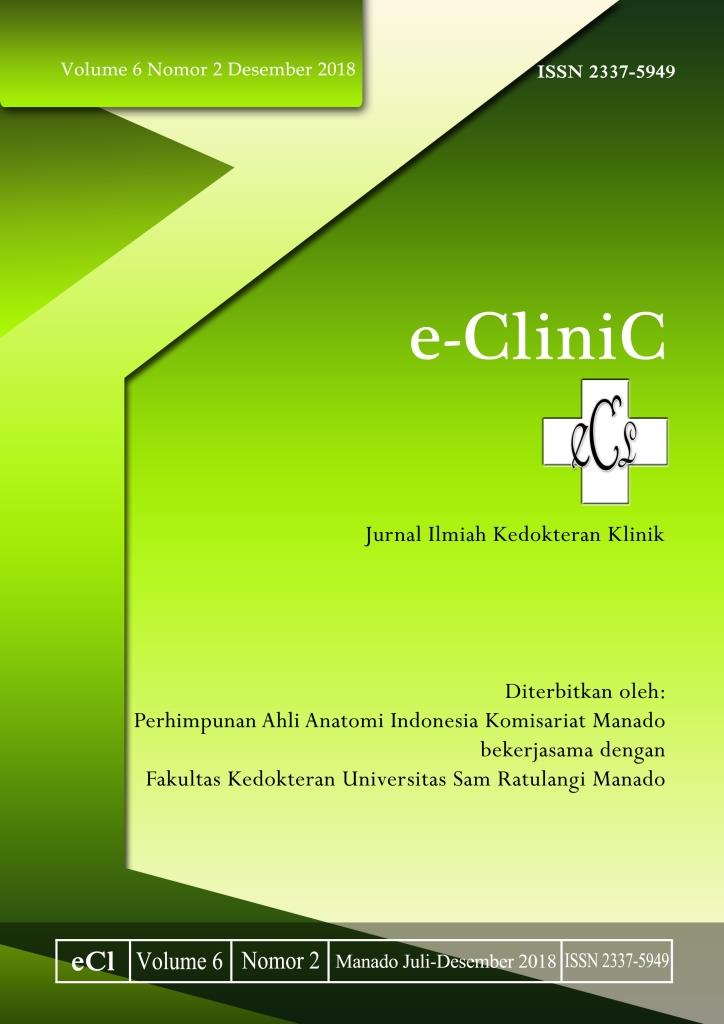Profil Gambaran Endoskopi di Pusat Endoskopi KSM Ilmu Penyakit Dalam RSUP Prof. Dr. R. D. Kandou Periode Januari 2016 – Desember 2017
DOI:
https://doi.org/10.35790/ecl.v6i2.22114Abstract
Abstract: Gastrointestinal endoscopy in the upper gastrointestinal tract is performed to obtain the condition of gastrointestinal mucosa. This study was aimed to obtain the profile of UGIB among endoscopy patients at the Gastrointestinal Endoscopy Center of Prof. Dr. R. D. Kandou Hospital Manado from January 2016 to December 2017. This was a descriptive retrospective study using medical records of patients who were registered at the Gastro-intestinal Endoscopy Center from January 2016 to December 2017. The result shows that from 420 cases, there were 7 diagnoses after endoscopy, as follows: esophagitis, gastritis, erosive gastritis, gastric ulcer, gastric polyp, duodenitis, and hiatal hernia. The most common diagnosis of UGIB was gastritis in 155 cases (37%), esophagitis in 124 cases (30%), duodenitis in 40 cases (10%), gastric polyp in 36 cases (9%), hiatal hernia in 22 cases (5%), erosive gastritis in 21 cases (4%), gastric ulcer in 17 cases (4%), and the other diagnoses (varices esophagus, esophagus ulcer, duodenum ulcer, achalasia) in 5 cases (1%). UGIB occured more common in males with 227 cases (54%) compared to female with 193 cases (46%). The most frequent age group was 56-65 years old with 86 cases, and the most rare case was >75 years old. Conclusion: Upper gastrointestinal bleeding occured more common among males, aged 56-65 years. Gastritis was the most common diagnosis in endoscopy.
Keywords: endoscopy, upper gastrointestinal bleeding
Â
Abstrak: Pemeriksaan endoskopi pada saluran cerna bagian atas berfungsi untuk mengeva-luasi keadaan mukosa saluran cerna atas dan sekitarnya. Penelitian ini bertujuan untuk mendapatkan profil gambaran endoskopi di Pusat Endoskopi KSM Ilmu Penyakit Dalam RSUP Prof. Dr. R. D. Kandou Manado periode Januari 2016 – Desember 2017. Jenis penelitian ialah deskriptif retroskpektif menggunakan data rekam medik pasien perdarahan SCBA yang melakukan pemeriksaan endoskopi periode Januari 2016 – Desember 2017. Hasil penelitian mendapatkan dari 420 kasus, ditemukan 7 diagnosis setelah tindakan endoskopi (EGD), yaitu esofagitis, gastritis, gastritis erosiva, gastric ulcer, polip gaster, duodenitis dan hernia hiatus. Diagnosis perdarahan SCBA terbanyak ialah gastritis 155 kasus (37%), esofagitis yaitu 124 kasus (30%), duodenitis 40 kasus (10%), polip gaster 36 kasus (9%), hiatus hernia 22 kasus (5%), gastritis erosiva 21 kasus (4%), gastric ulcer 17 kasus (4%), dan kasus dengan dignosis lainnya (varices esophagus, esophagus ulcer, duodenum ulcer, achalasia) sebanyak 5 kasus (1%). Perdarahan SCBA banyak terjadi pada pasien dengan jenis kelamin laki-laki berjumlah 227 pasien (54%) dibandingkan dengan pasien perempuan berjumlah 193 pasien (46%). Berdasarkan usia, terbanyak pada kelompok usia 56-65 tahun sebanyak 139 kasus dan terendah pada kelompok usia >75 tahun. Simpulan: Perdarahan SCBA lebih sering terjadi pada laki-laki, kelompok usia 56-65 tahun, dengan gastritis sebagai diagnosis terbanyak pada pasien perdarahan SCBA yang melakukan pemeriksaan endoskopi.
Kata kunci: endoskopi (EGD), perdarahan SCBA
Downloads
How to Cite
Issue
Section
License
COPYRIGHT
Authors who publish with this journal agree to the following terms:
Authors hold their copyright and grant this journal the privilege of first publication, with the work simultaneously licensed under a Creative Commons Attribution License that permits others to impart the work with an acknowledgment of the work's origin and initial publication by this journal.
Authors can enter into separate or additional contractual arrangements for the non-exclusive distribution of the journal's published version of the work (for example, post it to an institutional repository or publish it in a book), with an acknowledgment of its underlying publication in this journal.
Authors are permitted and encouraged to post their work online (for example, in institutional repositories or on their website) as it can lead to productive exchanges, as well as earlier and greater citation of the published work (See The Effect of Open Access).







